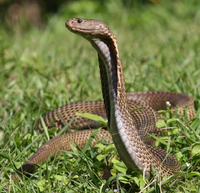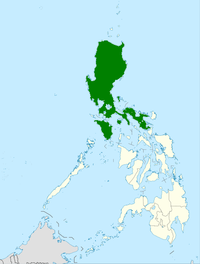Philippine cobra
| Philippine cobra | ||||||||||||||||||||
|---|---|---|---|---|---|---|---|---|---|---|---|---|---|---|---|---|---|---|---|---|
 Philippine cobra
| ||||||||||||||||||||
| Conservation status | ||||||||||||||||||||
| Scientific classification | ||||||||||||||||||||
| ||||||||||||||||||||
| Binomial name | ||||||||||||||||||||
| Naja philippinensis Taylor, 1922[2][3] | ||||||||||||||||||||
 Distribution of the Philippine cobra
| ||||||||||||||||||||
| Synonyms | ||||||||||||||||||||
|
The Philippine cobra (Naja philippinensis), also known as the Northern Philippine cobra, is a highly venomous species of spitting cobra native to the northern regions of the Philippine islands. It is often considered to be the most venomous of all the "true cobras" or all those species belonging to the genus Naja. Where it occurs in the northern Philippines, it is a significant cause of snakebites and fatalities. The Philippine cobra is called "ulupong" in Tagalog and "Agwason" in Cebuano-Bisaya.
Etymology
The Philippine cobra was described by American herpetologist Edward Harrison Taylor in 1922.[4] The generic name naja is a Latinisation of the Sanskrit word nāgá (नाग) meaning "cobra". The specific epithet philippinensis is Latin and literally means "from the Philippine Islands".[3]
Description
The Philippine cobra is a stocky snake of medium length that has long cervical ribs capable of expanding, so that when threatened a hood can be formed. The average length of this species is 1.0 m (3.28 ft) and rarely grows much longer. The species can grow to lengths of 1.6 m (5.25 ft), but this is exceptionally rare.[5] However, sub-populations of the species, particularly specimens from Mindoro Island, are said to attain lengths of 2 m (6.56 ft), but these are unverified and unconfirmed claims. If true, however, this would be very rare and would be considered the absolute maximum for this species.[6] The head is elliptical, depressed, slightly distinct from the neck with a short, rounded snout and large nostrils. The eyes are moderate in size with dark brown and round pupils, typical of other cobra species and similar to other elapids in general. It has a fairly stocky build for an elapid and adult snakes are uniformly light to medium brown, occasionally some lighter variegations do occur; juveniles are dark brown, with lighter variegations, sometimes a dark band behind the throat is visible.[7]
Scalation
They have 23-27 scale rows around the neck and 21 just above the middle part of the body; 182-193 ventrals, 36-49 subcaudals, and basal pairs are sometimes undivided.[7]
Distribution and habitat
Geographical distribution
The Philippine cobra is endemic to the Philippines. It occurs in the northern regions of the Philippine Islands. They can be found on the islands of Catanduanes, Luzon, Marinduque, Masbate, and Mindoro. It is also likely that this species may occur in other neighboring islands, but this remains unconfirmed. Records from the Calamianes group and Palawan require confirmation.[8]
Habitat
This terrestrial species is highly adaptable and is generally found in a wide range of habitats, from primary tropical moist forest to agricultural and urban areas. Philippine cobras inhabitat low-lying plains and forested regions, along with open fields, grasslands, dense jungle, agricultural fields, human settlements, and they can even be found in urban areas. This species of cobra is particularly fond of water and it can always be found very close to ponds, rivers, or large puddles of water. Although generally a low-lying plains snake, this species has been found up 800 m (2624.67 ft) above sea level.[1][5][9]
Behaviour and ecology
Behaviour and habits
This species of cobra is mainly terrestrial and diurnal, although it may become nocturnal in times of extremely hot weather. Generally a timid species, it usually tries to escape when encountered. It is a good climber and a good swimmer, so it can escape in different ways. If cornered, however, it will rear up, spread an impressive hood, and hiss loudly - warning its threat that a bite is imminent. If the scare tactic fails then the cobra will strike and bite as a last resort. Like many other snakes, this snake is most dangerous when surprised in close quarters. When biting, this species tends to hold on and chew savagely. This method of biting and latching on also gets more venom into the tissues as opposed to quickly striking and letting go, a method most other snakes use.[10]
Diet
This species feeds predominantly on small mammals, frogs, and even other snakes.[5] Small rodents such as mice and small rats are their preferred prey and makeup the majority of their diet. However, they will also eat other snakes, including juvenile King cobras, small lizards, frogs, eggs, and when the opportunity arises, small birds are also taken.[6][7]
Predators
Predators of this species of cobra include humans, birds of prey, the King cobra, and the mongoose.[9]
Conservation status
This species is classified as Near Threatened (NT) on the IUCN Red List of Threatened Species (v3.1, 2011). The conservation status of this species was last assessed in 2009. It was listed as such because this species is heavily persecuted in some areas, and is also widely traded at a low level. It is presumably declining due to these threats, and is now rarely seen during herpetological surveys. The species appears to approach the threat criteria of A2d, A3d, and A4d. The species is widely persecuted, especially in and around agricultural areas. Animals are collected for the exotic food trade (within the Philippines), and to a much lesser degree, for the pet trade. This snake is also collected and used for antivenom production by the Research Institute for Tropical Medicine (RITM).
In view of the species wide range, it is presumably present in some protected areas. Awareness programmes are needed to reduce levels of persecution. Better control and enforcement of legislation to regulate the exotic food trade is also needed. International trade in this species is regulated by CITES.
Venom
The venom of the Philippine cobra is a potent post-synaptic neurotoxin which affects respiratory function and can cause neurotoxicity and respiratory paralysis, as the neurotoxins interrupt the transmission of nerve signals by binding to the neuro-muscular junctions near the muscles. Research done on the venom of this species has shown that its venom is purely a neurotoxin, with no apparent necrotizing components (cytotoxins) and no cardiotoxins.[11] They are capable of accurately "spitting" their venom at a target that is up to 3 m (9.84 ft) away from where they are. The symptoms of a bite might include headache, nausea, vomiting, abdominal pain, diarrhea, dizziness, and difficulty breathing.[12]
Bites by the Philippine cobra produce prominent neurotoxicity with minimal to no local signs. A study of 39 patients envenomed by the Philippine cobra (Naja philippinensis) was conducted in 1988. Neurotoxicity occurred in 38 cases and was the predominant clinical feature. Respiratory paralysis developed in 19 patients, and was often rapid in onset-in 3 cases apnea occurred within 30 minutes of the bite. There were 2 deaths, both in patients who were moribund upon arrival at the hospital. Three patients developed necrosis, and 14 individuals with systemic symptoms had no local swelling at all. Both cardiotoxicity and reliable nonspecific signs of envenoming were absent. Bites by the Philippine cobra produce a distinctive clinical picture characterized by severe neurotoxicity of rapid onset and minimal local tissue damage.[11]
Although venom toxicity values can vary greatly even among specimens of the same species, the Philippine cobra has the most toxic venom among all of the Naja (cobra) species according to all known toxicological studies which give the species a value (only conducted on mice), thus making it the most venomous cobra species in the world. The subcutaneous LD50 for this species is 0.20 mg/kg and the average venom yield per bite is 90–100 mg (with a maximum yield of 250 mg).[13] In comparison, the corresponding subcutaneous LD50 for the Indian cobra venom is 0.8 mg/kg according to Dr. Thomas Brown.[13] Subcutaneous LD50 values for other cobra's include 1.15 mg/kg for the Egyptian cobra, 2 mg/kg for the Black-necked spitting cobra, 0.72 mg/kg for the Cape cobra,[14] and 0.53 mg/kg for the Chinese cobra.[15]
Cited references
- ↑ 1.0 1.1 Naja philippinensis. The IUCN Red List of Threatened Species. IUCN Red List of Threatened Species. Retrieved on 18 May 2012.
- ↑ Naja philippinensis (TSN 700637) at Integrated Taxonomic Information System. Accessed 18 May 2012.
- ↑ 3.0 3.1 Naja philippinensis TAYLOR, 1922 at The Reptile Database. Accessed 18 May 2012.
- ↑ Taylor, E.H. 1922. The snakes of the Philippine Islands. Manila (Bureau of Printing or Science), Monograph 16: 312 pp.
- ↑ 5.0 5.1 5.2 Naja philippinensis: General Details. Clinical Toxinology Resource. The University of Adelaide. Retrieved on 18 May 2012.
- ↑ 6.0 6.1 Lutz, M. 2006. Die Kobras des philippinischen Archipels, Teil I: Die Philippinen-Kobra, Naja philippinensis TAYLOR 1922. Sauria 28 (3): 5-11
- ↑ 7.0 7.1 7.2 Wüster, Wolfgang (1993). "A century of confusion: Asiatic cobras revisited". Vivarium 4 (4): 14–18. Retrieved on 18 May 2012.
- ↑ Wüster, Wolfgang (1996). "Taxonomic changes and toxinology: Systematic revisions of the Asiatic cobras (Naja naja species complex)". Toxicon 34 (4): 399–406. PMID 8735239. Retrieved on 18 May 2012.
- ↑ 9.0 9.1 Wüster , W. & R.S. Thorpe. (1990). Systematics and biogeography of the Asiatic cobra (Naja naja) species complex in the Philippine Islands. In G. Peters & R. Hutterer (Eds.), Vertebrates in the Tropics: 333-344. Museum A. Koenig, Bonn (Naja naja) species complex in the Philippine Islands
- ↑ Philippine cobra at Armed Forces Pest Management Board. Accessed 18 May 2012.
- ↑ 11.0 11.1 Watt, G.; Padre L, Tuazon L, Theakston RD, Laughlin L. (September 1988). "Bites by the Philippine cobra (Naja naja philippinensis): prominent neurotoxicity with minimal local signs". The American Journal of Tropical Medicine and Hygiene 39 (3): 306–11. PMID 3177741. Retrieved on 1 December 2011.
- ↑ Envenomation and Treatment
- ↑ 13.0 13.1 Brown, JH (1973). Toxicology and Pharmacology of Venoms from Poisonous Snakes.. Springfield, Illinois: Charles C. Thomas, 184. ISBN 0-398-02808-7.
- ↑ Fry, Bryan Grieg. Subcutaneous LD50. Australian Venom Research Unit. University of Queensland. Retrieved on 18 May 2012.
- ↑ Snakes of medical importance. Singapore: Venom and toxic research group, 253. ISBN 9971-62-217-3.
